Mushrooms
Media
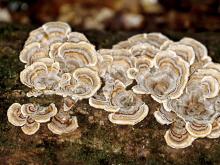
Species Types
Scientific Name
Trametes versicolor
Description
Turkey tail grows in clusters of leathery, thin brackets with multicolored zones above and whitish yellow pores below. Look for it on stumps and logs of deciduous trees.
Media
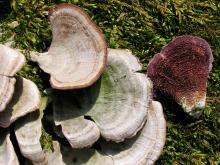
Species Types
Scientific Name
Trichaptum biforme
Description
The violet toothed polypore is a bracket fungus with tough, hairy caps with violet margins and zones of white, brown, and black; beneath, the whitish violet pores break into teeth. It grows on stumps and logs of deciduous wood.
Media
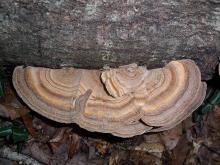
Species Types
Scientific Name
Lenzites betulina
Description
Multicolor gill polypore is a bracket fungus with a semicircular, tough, hairy, multicolored, zoned cap; beneath, it's white, with leathery, gill-like tubes. It grows on dead deciduous wood.
Media
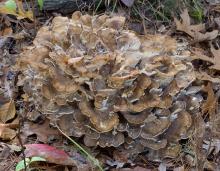
Species Types
Scientific Name
Grifola frondosa
Description
Looking like a ruffled chicken, the edible hen of the woods mushroom grows like large circular bouquet of spoon-shaped caps, each grayish brown on top and white beneath, emerging from a branching, whitish base. It grows on the ground at the base of oak trees.
Media
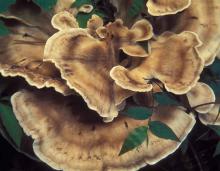
Species Types
Scientific Name
Meripilus sumstinei (formerly M. giganteus)
Description
The black-staining polypore grows in large, circular clusters of many fleshy, grayish yellow, fan-shaped caps, which bruise black when cut or touched. It grows on the ground around deciduous trees, especially oaks.
Media
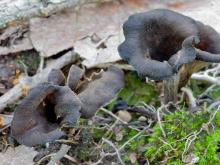
Species Types
Scientific Name
Craterellus cornucopioides (C. fallax)
Description
The black trumpet is dark brown to black, vase- or trumpet-shaped, with a wavy margin and no gills. It grows in groups of few to many on rocky, mossy hillsides in deciduous woods.
Media
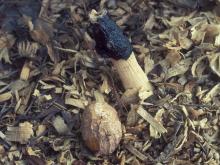
Species Types
Scientific Name
Phallus ravenelii
Description
Ravenel's stinkhorn is a long, whitish column with a greenish, smelly slime covering the top, and a whitish or pinkish cup around the base. It grows on wood debris, mulch, rotted stumps, and sawdust, and in deciduous woods.
Media

Species Types
Scientific Name
Xylaria polymorpha
Description
Dead man’s fingers is a black, distorted, clublike or finger-shaped fungus with a wrinkled, charcoal-like surface. It grows in clusters at the base of rotting deciduous trees and stumps.
Media
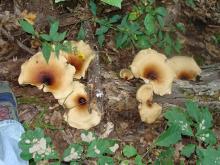
Species Types
Scientific Name
Polyporus badius
Description
The black-footed polypore has a smooth, wavy brown cap with whitish or tannish pores on the underside and a black, smooth, off-center stalk. It grows singly or in groups of up to several on dead wood and stumps of deciduous trees.
Media
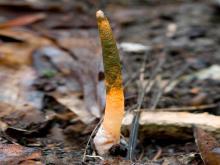
Species Types
Scientific Name
Mutinus elegans
Description
The elegant stinkhorn is a long, tapered, pinkish orange column with a greenish brown, smelly slime covering the top and a white cup around the base. It grows on leafy debris, mulch piles, and rotting wood.
See Also

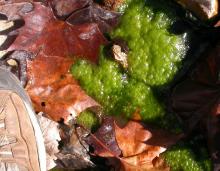
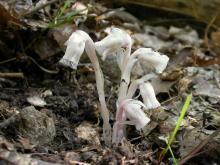
Media

Species Types
Scientific Name
Monotropa hypopitys
Description
Pinesap is a plant that puts the "wild" in wildflower! It lacks chlorophyll, so its roots connect to fungi underground and absorb nutrients from the fungi.
Media

Species Types
Scientific Name
Cladophora, Pithophora, and Spirogyra spp., and others
Description
Filamentous green algae forms green, cottony masses that are free-floating or attached to rocks, debris, or other plants.
Media

Species Types
Scientific Name
Monotropa uniflora
Description
Indian pipe lacks chlorophyll, so it is white, not green. Below ground, its roots join with fungi that connect to tree roots. This plant, then, takes nourishment indirectly from the trees.
About Mushrooms in Missouri
Mushrooms are a lot like plants, but they lack chlorophyll and have to take nutrients from other materials. Mushrooms are neither plants nor animals. They are in a different kingdom — the fungi. Fungi include the familiar mushroom-forming species, plus the yeasts, molds, smuts, and rusts.
Always be cautious when eating edible mushrooms. Be absolutely sure of the ID, and only eat a small amount the first time you try it to avoid a reaction..





















